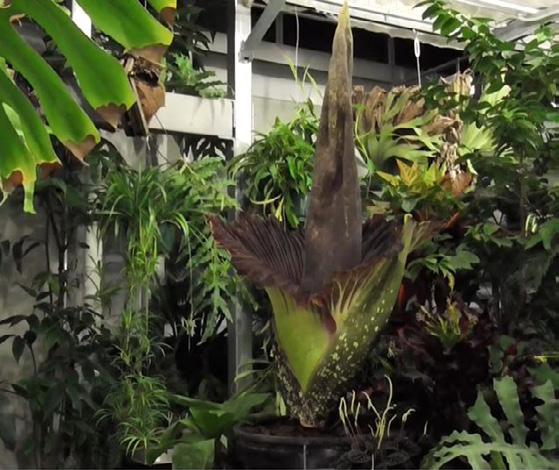
2 minute read
UWM greenhouse enjoys a rare bloom from the “Corpse Flower”
On April 17, the first-ever Titan Arum bloomed at the UWM Biological Sciences Greenhouse. The Titan Arum, or “Corpse Flower,” is recorded to have the largest, and one of the smelliest, inflorescences of the plant world.
Convention dictates that an individual Titan Arum plant is named upon its very first bloom. The Biological Sciences Department affectionately named theirs ‘Hoot’, in honor of Dr. Sara Hoot. Currently, UWM’s Biological Sciences instructional collection maintains nine individual Amorphophallus titanum plants.
Life Cycle of the Titan Arum
The Corpse Flower, or Titan Arum, is native to the rainforests of Sumatra in Indonesia. They are uncommon in the wild and are under considerable population pressure as their native habitats are rapidly being destroyed, primarily due to illegal logging and land conversion for agricultural use. As of 2020, A. titanum is listed as endangered by the International Union for Conservation of Nature (IUCN).

The Titan Arum, or Corpse Flower. Photo courtesy of the UWM Biological Sciences Department.
A. titanum grows from a corm, which in older specimens have been documented weighing up to 198 pounds. From the corm, a single umbrella-like leaf composed of a trunklike petiole topped with an array of leaflets will emerge, photosynthesizing and storing food for 9-12 months (in our greenhouse).
Next, the leaf will senesce (die back) and the plant will go dormant. The dormancy period of the Biological Sciences Department’s specimens varies from 2-5 months. The process then repeats itself until the plant sends up a flower bud instead of a leaf. In cultivation, this will average 7-10 years after seed germination. Blooming is considered a very rare event in cultivation and even more rare in the wild. The average A. titanum bloom grows roughly 6.5 feet tall, making it the largest unbranched inflorescence in the world.
Alas, the Titan Arum is not the world’s largest individual flower. This title is held by Rafflesia arnoldii, another stinky flower, also named Corpse Flower. A titanum‘s bloom is a flower structure consisting of a tall spadix (spike) wrapped by a spathe (a frilly modified leaf). The flowers themselves are quite small and form a small cluster at the base of the structure. The male flowers are located on the top of this cluster and release pollen, and the female flowers are located on the bottom of the cluster.

Wendy Semski, a graduate student in Biological Sciences professor Jeff Karron’s lab, poses with “Hoot,” a Corpse Flower that recently bloomed in the UWM Greenhouse. Photo courtesy of the Biological Sciences Department.
A unique smell
While the foliage is stunning, it is the fragrance, the smell of decaying animal flesh, from this inflorescence that gives the A. titanum its namesake of the “Corpse Plant”. As evening approaches, the female flowers open, thermogenesis begins and the spadix heats up to 98.6 degrees Fahrenheit, volatilizing its pungent scent, trying to entice pollinators such as carrion beetles, flies, and other insects that are active at night. Dr. Kite of the Royal Botanic Gardens at Kew found the key odorants to be sulfides; dimethyl trisulfide (a rotting, animal-like sulfury odor) and dimethyl disulfide (a garlic-like smell).
Other compounds present include isovaleric acid, (the smell of sweaty feet) and methylthiol acetate (an unsavory blend of moldy garlic and rotten cheese).
The next day, the male flowers open. Within 24-48 hours of maturity, the smell dissipates, the flower structure begins to wilt and eventually collapses, having expended most of its energy. Trimethylamine is released (the source of that lovely rotting fish smell), and hopefully the plant had a successful pollination event!
By the UWM Biological Sciences Department








